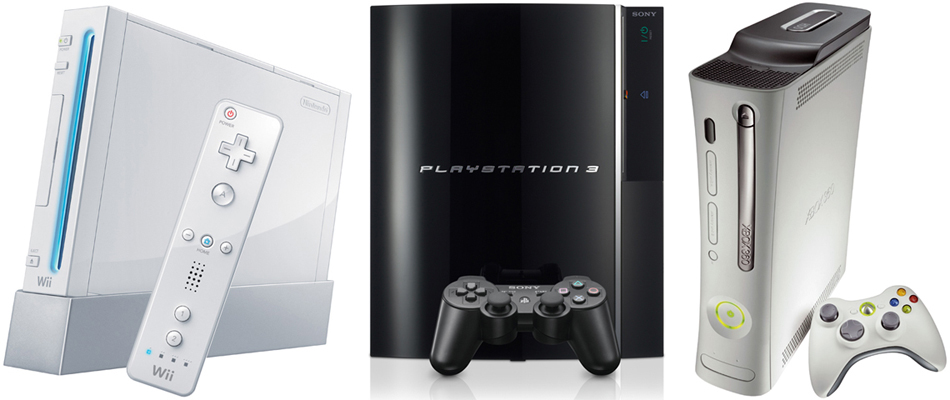
Video Games Today
We are currently in the 7th generation of video game consoles. Although there are many different devices out there that can be considered a platform to play video games, I will only consider the major players. For more information about the history of video games or to look at some of the more obscure consoles, please use Wikipedia or Video Game Console.
| Consoles | Handhelds | Personal Computers | Current Trends |

Today, more than before, video game consoles are centered on major companies. Sega has dropped out of the console race, and other developers have become unable to get into the market (such as the Phantom). For video game consoles in this modern age (considered in the 7th generation), there are only 3 major players: Sony's Playstation 3, Microsoft's X-Box 360, and Nintendo's Wii. All 3 consoles have their strengths and weaknesses, which video game enthusiasts (like me) have carefully considered and analyzed. To prevent boring you, I'll just list only the basic arguments. Before you hooligans start screaming, I will acknowledge that I have only put some very general views that might be colored by my own interpretations. Have we calmed down? Good. Let's keep going. The Playstation 3 markets itself as an entertainment system, a piece of hardware that functions as an Internet browser, Blu Ray player, music player, social networking device (through Playstation Home), and a gaming console. Although it is a major contender now, it was a joke in its first year and perhaps second year; it offered mostly boring or broken games, was overpriced at nearly $600 (compared to X-Box 360's debuting $400 and Wii's $280), and had a slew of public relations disasters due to clueless or ignorant representatives. Still, it improved considerably and is, without a doubt, the most powerful gaming console on the market right now, with many quality titles. The X-Box 360, on the other hand, started out a year earlier than the Playstation 3 and Wii, and it has garnered a reputation as the console to turn to for first-person shooters. However, it has also garnered a reputation as a console with an alarming rate of failure, especially with its "Red Ring of Death" (which indicates an internal problem that requires service). The Playstation 3 and X-Box 360 are fiercely locked in competition for the adolescent and adult male demographic and seem to market mainly on the basis of graphics. The Wii is the ensemble darkhorse of the bunch. It is small, underpowered, and relatively cheap, yet it seems to hold the most potential. It emphasizes its motion-based controls rather than its processing power, and it seems to have targeted every other demographic. Guess what? It worked. The Wii is currently the top-selling console with a stranglehold on females, families, the elderly, and the disabled. As a consequence, though, its gaming library seems to be composed largely of poor-quality games.

The handheld market has traditionally been less competitive, with Nintendo's Game Boy and Game Boy Advance series dominating the market for nearly two decades. However, this generation has brought some major competitors to Nintendo's throne: Sony's PSP (Playstation Portable) and Apple's iPhone. The Playstation Portable series is like the Playstation 3, as it is marketed as an entertainment system for Internet browsing, music and videos, and portable games. On the other hand, although the Playstation Portable has sold a respectable number of units and games, it has not surpassed Nintendo's DS. Nintendo's DS (often referred to as "dual screen" but is official known as "developers' system") is like the Wii, in that it also tries to appeal to the wider demographics. This time it does so through the virtue of having a touch screen, and it also works. I think the image to your left sums up its profitability. Unlike the Wii, however, the DS game library is considerably stronger as a whole. The iPhone is not a device that most people consider a handheld gaming console, but its business model of downloadable games has caught the attention of developers, no doubt attracted by the impressive profitability that it has displayed. Time will tell whether this competes with, compliments, or ignores the market held by the PSP and DS.
There is one video game platform that I have not mentioned, and that is the personal computer. It is difficult to address computers because they vary in terms of gaming suitability and there is no "license" required to develop and publish games for it (i.e. do not have to have permission from the console-maker to make games on it). Although games have changed greatly as computers themselves have changed, there is nowhere near the level of competition of other gaming platforms. I guess that's all I could say about that platform.
Currently, the trend of video games seems to be headed by just one thing: the Internet. In this regard, the increasing ability for the Internet to connect people has lead to the advent of downloadable games. Each gaming console has downloadable games and they make more and more money each year. Gaming companies now seem more inclined to let the user download the game rather than buy a physical copy, because they would be accessible to more people. In a way, piracy would be limited due to the lack of regional lockout imposed on the games. Eventually, it is believed that all games will be downloaded instead of on disk. With the increasing ability of the Internet to connect people also comes the rise of online multiplayer games. More and more games are being designed with online multiplayer in mind as we seem to become chattier and chattier. Game developers and publishers are now looking at advertisements as a mainstream source of revenue, which would only be possible if people went online with their games. The easiest way to do this, of course, is to attract others and allow the players to "provide" the game content.